New UC Davis Center Paves the Way for Rock Dust Research
If the world were to judge soil remineralization based on what could happen, rock dust amendments might already be standard procedure for the world’s farmers. The potential to use rock dust as a carbon storage tactic for climate change mitigation is well known in the scientific community, in addition to its ability to improve agricultural yields and soil health. Benefits like these are enough to make any policymaker or farmer at least consider the use of soil amendment programs, but expectations alone are not adequate to persuade any party to go “all in.”
Stakeholders include farmers, ranchers, politicians, business owners, and everyday citizens, and all need assurances in the form of comprehensive experiments, hard numbers and promising data sets before any large scale implementation can be arranged. They need to know what financial obligations to expect, any side effects caused by remineralization, and the specific and varying levels of benefit that can be expected from doing so at scale. As is a commonly frustrating but necessary reality for environmental solutions, their adoption must rely on sound scientific understanding and cost-effective strategy, and these concerns have been left relatively unexplored by scientific research in the past. However, faculty at the University of California are changing this narrative.
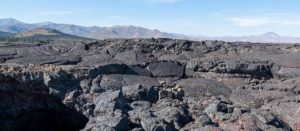
An expanse of basalt rock. Buried within may be the secret to increased crop yields, more nutritious foods, and affordable carbon sequestration.
source: https://www.workinglandsinnovation.com/news
The University is currently carrying out several remineralization studies across multiple campuses that they hope will deliver a more holistic understanding of California soils’ carbon storage potential, and may validate the efficacy of using rock dust to combat climate change and soil degradation. Their keystone project will focus on carbon storage potential and effects on plant growth in California croplands, while other projects will explore effects of different soil components, modeling improvements and performing a thorough cost-benefit analysis. Where previous research has focused mainly on the physical and chemical processes of soil remineralization, the team at UC Davis plans to explore financial impacts, scalability, and the varying levels of benefit for different climates and soils. In short, their work aims to map out the “Yellow Brick Road” piece by piece rather than merely claiming that the road exists in the first place. With this approach, researchers can transcend the scientific community’s current understanding of rock dust to manifest a plan for realistic implementation in the future.
Experiments and Methodology
Given that one quarter of annual global carbon emissions come from agriculture and forestry, it’s only natural that UC Davis staff would devote resources to improving agriculture’s footprint. Under the Working Lands Innovation Center at UC Davis, teams of researchers are doing just that. The “WLIC,” as it’s known around campus, “aims to catalyze negative carbon emissions by deploying soil amendment technologies at multi-acre scales in partnership with California researchers, state agencies, industry, farmers, ranchers, tribes, and small business development.” Their work largely revolves around revolutionizing agricultural production in terms of efficiency and minimal carbon footprint; aims that the group believes can be achieved by means of basaltic rock remineralization.
Los Banos Cropland Study
The Houlton Lab, a subordinate of the WLIC, is in the midst of completing a sizable farming experiment that will compare and contrast impacts on remineralized lands with sub-divisions of land that received no rock dust, acting as the control group. The study will quantitatively illustrate what benefits California stands to gain from employing methods of remineralization, specifically those related to sequestration and crop yields. The remineralized sections of the farm, located in Los Banos, California, received about 16 tons of rock dust per acre last year. The rock dust is mostly metabasalt, a variety high in iron, zinc, and potassium that delivers elements necessary for healthy plant growth. Metabasalt supplies additional nutrients compared with artificial NPK fertilizers, and they require less fossil fuel to produce. These rocks break down by natural weathering processes that release trace elements back into the soil. There, the elements react and bond with carbon dioxide molecules to form carbonate and bicarbonate rock, removing greenhouse gases from the atmosphere and storing them in a solid form in our soils.
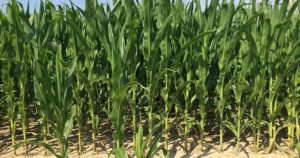
Corn grown at the Los Banos Farm using rock dust, compost, and biochar. Early results look more than promising. Photo from workinglandsinnovation.com
Additionally, a sub-experiment within the overall project will observe differences in the application of rock dust to organic soils versus conventional soils, as well as benefits for corn fields versus those observed in alfalfa fields. In this sense, the terms “organic” and “conventional” refer to fields that have been fertilized using natural amendments like compost as opposed to those maintained using artificial fertilizers, respectively. Corn and alfalfa plants were used given their popularity and applicability to a broad range of global landscapes and climates.
Researchers will also be tracking water retention rates, biomass growth benefits and conducting a cost-benefit analysis to understand feasibility for farmers. Plots will be divided, maintained, and monitored for more than a year’s time to observe growth characteristics and measure other changes in the land.
Although the team has yet to publish any official results, Ben Houlton, team leader and former director of the John Muir Institute for the Environment, was adamant about rock dust’s potential. He says that so far, remineralized organic crop fields are “yielding 30 percent more biomass” than their conventional counterparts. While the team is yet to say exactly how much carbon is being stored, members are confident that their findings will be significant. According to Houlton, the group’s preliminary results predict that remineralizing all California croplands at moderate levels could sequester between 30 and 80 million metric tonnes of carbon each year.
Silver Lab, UC Berkeley
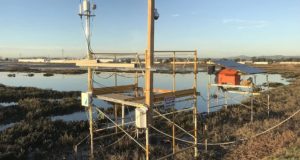
This instrument uses the eddy covariance method to measure carbon dioxide emissions at ecosystem-scale. Tools like this will be vital to create accurate sequestration models and manage expectations for remineralization potential.
To store enough carbon to mitigate the effects of climate change, rock dust would need to be applied to lands around the world, not just in California. While the Houlton lab is studying remineralization through a micro lens, team members at the Silver Lab on the UC Berkeley campus are taking a macro approach. Specifically, the lab is exploring how to scale up the remineralization process in a financially viable way that will illuminate a pathway to national and global adoption. This includes the use of biochar and compost amendments in addition to rock dust, additives that may work in unison to improve soil health and provide greater returns for farmers in the long run. While there would be increased farming costs associated with procuring, transporting, and scattering these amendments, researchers are confident that these could be offset by the elimination of annual pesticide applications and the capital gained from increased crop yields. These are the net benefits the Silver Lab hopes to quantify. The team is also studying what forms of carbon remain in the soil the longest, which can help improve the accuracy of soil models and create more realistic expectations for stakeholders. The hope is that more accurate models will demonstrate remineralization’s potential to other states and countries, inspiring them to conduct trials of their own and adopt these techniques.
Parikh Lab
Simultaneous to the work being done at the Houlton and Silver Labs, staff within UC Davis’ Parikh Lab are exploring technologies that will help them understand how soil composition may affect sequestration potential from region to region. Team members at the lab are studying the interactions of organic material, soil microbes, mineral surfaces of rocks and other factors to grasp the interactive processes that play out, and what their effects might be on carbon sequestration capability. To do this, scientists are utilizing infrared and x-ray technology that can identify the physical make-up of a soil sample, which they then analyze to approximate how much carbon could be stored in a particular volume of that composition. In terms of modeling, scientists want to know as much about a sample as possible to ensure that they can accurately predict outcomes. Technologies like this will be vital for estimating carbon storage quantities, which will in turn improve scientists’ and politicians’ ability to create realistic timelines for sequestration potential regardless of the soil type or region.
Looking Ahead
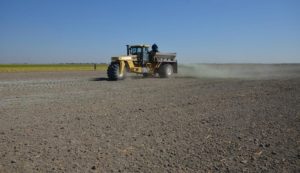
Much of the equipment used to spread rock dust across crop lands already exists. A farmer here prepares a plot for remineralized agriculture using his tractor and a simple dump attachment.
Source: https://cals.cornell.edu/news/benjamin-z-houlton-investing-agriculture-climate-resilient-future
The UC school system’s initiative to study soil amendments as a means to fight climate change is something we should all celebrate. At Remineralize The Earth, we know about the past success stories of using rock dust, compost, and biochar to restore soils and sequester carbon, and the commitment by such a reputable organization as the University of California to this mission is a one-of-its-kind victory. By the UC system conducting such thorough research, the United States and world abroad will gain a more holistic idea of how to implement remineralization practices, and increase the likelihood that rock dust will one day be a vital piece to the global climate change strategy. Unlike many other ideas, remineralization stands a real chance to not only lower environmental impact but do so in a way that can improve economic growth for farmers and industry at the same time. Although these studies have not yet concluded, the combination of their preliminary observations and the results of those studies that came before should inspire hope for a greener future. Remineralization alone will not be enough to solve the climate crisis, but this is a clear and immense step towards salvation that humanity should see as a bright light given our uncertain future on this planet.
William Binette is a recent graduate from the University of Colorado Boulder helping the RTE team in grant acquisition and content writing for our website. Holding a bachelors degree in environmental studies with a focus on environmental governance, Will looks to combine his education and written communication skills to bring remineralization techniques into the spotlight of climate change policy. In his spare time, Will enjoys hiking, skiing, camping, and other activities that allow him to spend time in wilderness. In addition to his contributions to RTE, Will works on freelance writing projects and repairs outdoor recreation equipment.
Support us on Patreon
Thank you for joining us today! Please become a member of RTE and support us on Patreon. Unlike many larger organizations, we work with a team of determined and passionate volunteers to get our message out. We aim to continue to increase the awareness of remineralization to initiate projects across the globe that remineralize soils, grow nutrient dense food, regenerate our forests’ and stabilize the climate – with your help! If you can, please support us on a monthly basis from just $2, rest assured that you are making a big impact every single month in support of our mission. Thank you!

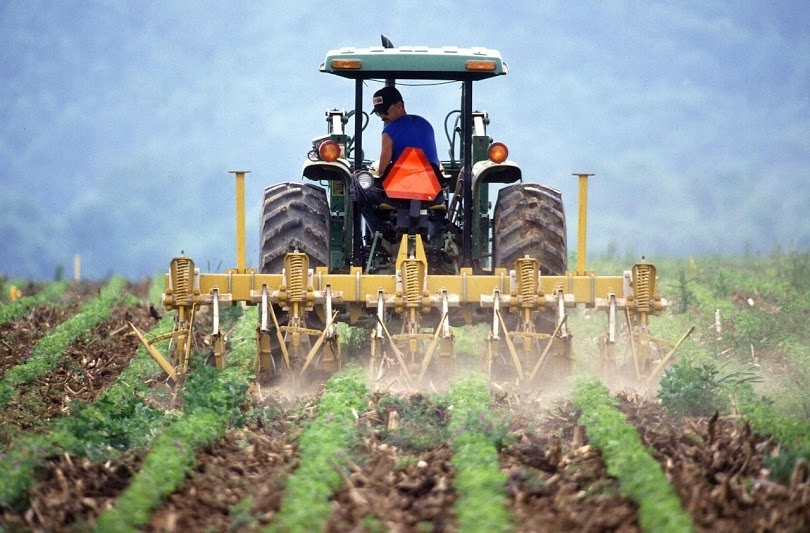






Got something to say?